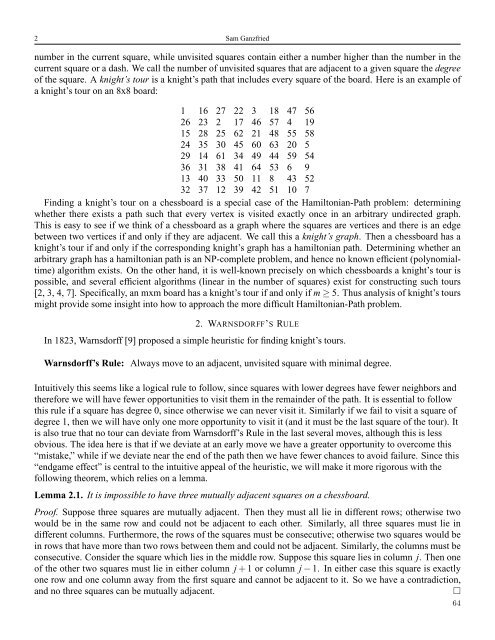A SIMPLE ALGORITHM FOR KNIGHT'S TOURS Chess is a two ...
A SIMPLE ALGORITHM FOR KNIGHT'S TOURS Chess is a two ...
A SIMPLE ALGORITHM FOR KNIGHT'S TOURS Chess is a two ...
Create successful ePaper yourself
Turn your PDF publications into a flip-book with our unique Google optimized e-Paper software.
2 Sam Ganzfriednumber in the current square, while unv<strong>is</strong>ited squares contain either a number higher than the number in thecurrent square or a dash. We call the number of unv<strong>is</strong>ited squares that are adjacent to a given square the degreeof the square. A knight’s tour <strong>is</strong> a knight’s path that includes every square of the board. Here <strong>is</strong> an example ofa knight’s tour on an 8x8 board:1 16 27 22 3 18 47 5626 23 2 17 46 57 4 1915 28 25 62 21 48 55 5824 35 30 45 60 63 20 529 14 61 34 49 44 59 5436 31 38 41 64 53 6 913 40 33 50 11 8 43 5232 37 12 39 42 51 10 7Finding a knight’s tour on a chessboard <strong>is</strong> a special case of the Hamiltonian-Path problem: determiningwhether there ex<strong>is</strong>ts a path such that every vertex <strong>is</strong> v<strong>is</strong>ited exactly once in an arbitrary undirected graph.Th<strong>is</strong> <strong>is</strong> easy to see if we think of a chessboard as a graph where the squares are vertices and there <strong>is</strong> an edgebetween <strong>two</strong> vertices if and only if they are adjacent. We call th<strong>is</strong> a knight’s graph. Then a chessboard has aknight’s tour if and only if the corresponding knight’s graph has a hamiltonian path. Determining whether anarbitrary graph has a hamiltonian path <strong>is</strong> an NP-complete problem, and hence no known efficient (polynomialtime)algorithm ex<strong>is</strong>ts. On the other hand, it <strong>is</strong> well-known prec<strong>is</strong>ely on which chessboards a knight’s tour <strong>is</strong>possible, and several efficient algorithms (linear in the number of squares) ex<strong>is</strong>t for constructing such tours[2, 3, 4, 7]. Specifically, an mxm board has a knight’s tour if and only if m ≥ 5. Thus analys<strong>is</strong> of knight’s toursmight provide some insight into how to approach the more difficult Hamiltonian-Path problem.2. WARNSDORFF’S RULEIn 1823, Warnsdorff [9] proposed a simple heur<strong>is</strong>tic for finding knight’s tours.Warnsdorff’s Rule: Always move to an adjacent, unv<strong>is</strong>ited square with minimal degree.Intuitively th<strong>is</strong> seems like a logical rule to follow, since squares with lower degrees have fewer neighbors andtherefore we will have fewer opportunities to v<strong>is</strong>it them in the remainder of the path. It <strong>is</strong> essential to followth<strong>is</strong> rule if a square has degree 0, since otherw<strong>is</strong>e we can never v<strong>is</strong>it it. Similarly if we fail to v<strong>is</strong>it a square ofdegree 1, then we will have only one more opportunity to v<strong>is</strong>it it (and it must be the last square of the tour). It<strong>is</strong> also true that no tour can deviate from Warnsdorff’s Rule in the last several moves, although th<strong>is</strong> <strong>is</strong> lessobvious. The idea here <strong>is</strong> that if we deviate at an early move we have a greater opportunity to overcome th<strong>is</strong>“m<strong>is</strong>take,” while if we deviate near the end of the path then we have fewer chances to avoid failure. Since th<strong>is</strong>“endgame effect” <strong>is</strong> central to the intuitive appeal of the heur<strong>is</strong>tic, we will make it more rigorous with thefollowing theorem, which relies on a lemma.Lemma 2.1. It <strong>is</strong> impossible to have three mutually adjacent squares on a chessboard.Proof. Suppose three squares are mutually adjacent. Then they must all lie in different rows; otherw<strong>is</strong>e <strong>two</strong>would be in the same row and could not be adjacent to each other. Similarly, all three squares must lie indifferent columns. Furthermore, the rows of the squares must be consecutive; otherw<strong>is</strong>e <strong>two</strong> squares would bein rows that have more than <strong>two</strong> rows between them and could not be adjacent. Similarly, the columns must beconsecutive. Consider the square which lies in the middle row. Suppose th<strong>is</strong> square lies in column j. Then oneof the other <strong>two</strong> squares must lie in either column j + 1 or column j − 1. In either case th<strong>is</strong> square <strong>is</strong> exactlyone row and one column away from the first square and cannot be adjacent to it. So we have a contradiction,and no three squares can be mutually adjacent.□64
















